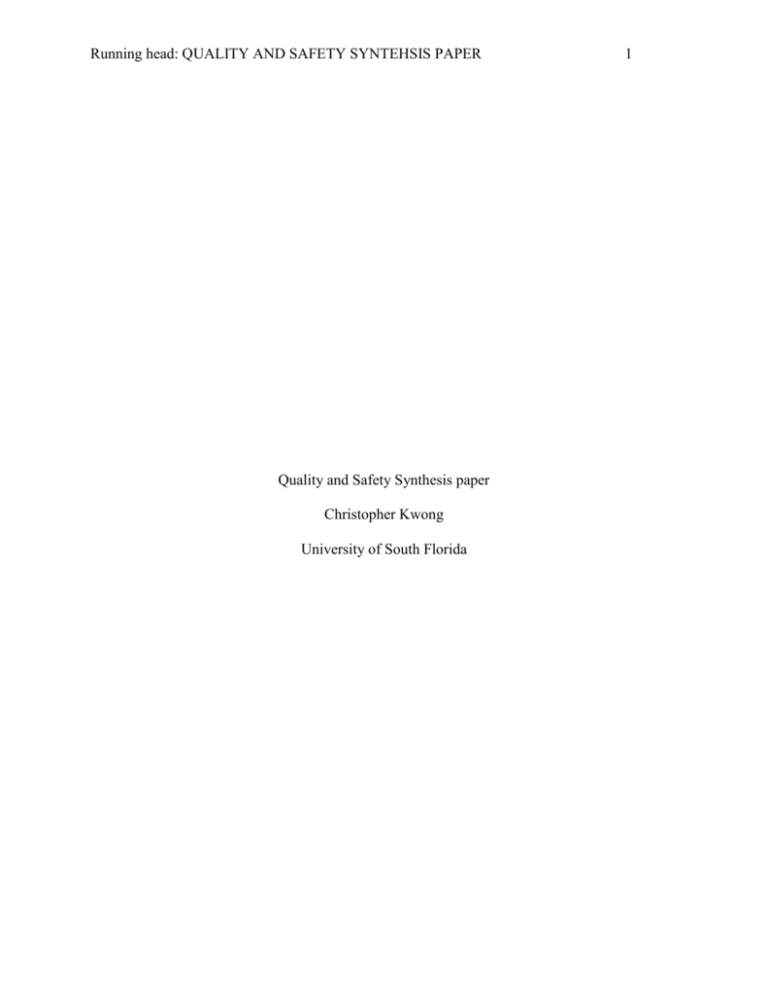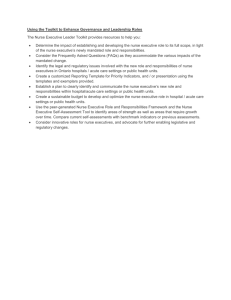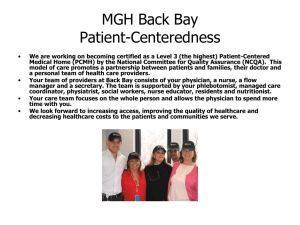File - Personal Intro & Goals
advertisement

Running head: QUALITY AND SAFETY SYNTEHSIS PAPER Quality and Safety Synthesis paper Christopher Kwong University of South Florida 1 QUALITY AND SAFETY SYNTEHSIS PAPER 2 In a bachelor’s degree program, we spend a tremendous amount of time learning and analyzing the practices of care providers that enhance the quality and safety of care. Entire courses during the program are dedicated to them such as evidenced-based practice. Clinical hours afford us the opportunity to not only participate in patient care, but also witness quality and safety competencies in action all around the hospital. The following discusses the constant adaptation and refinement of quality and safety in our practice in the areas of how patientcentered care, teamwork and collaboration, evidence-based practice, quality improvement, safety, and informatics help improve the outcomes for patients. Because our clinical experience has been primarily in the acute care setting, we examine the American Hospital Association’s (AHA) position on quality and patient safety. It sets forth towards: “Delivering the right care at the right time in the right setting is the core mission of hospitals across the country. The AHA is committed to helping members improve the quality of care they deliver every day. We do so by providing information and assistance on how to improve care and by working with federal lawmaker, regulators and research agencies to create a policy environment on which quality and safety can thrive” (American Hospital Association, 2013). Their vision is of a society of healthy communities where all individuals reach their highest potential for health. The AHA has a strong, hopeful vision in a reality where economics, politics, disease, and violence threaten it. We had the opportunity to discuss acute care quality and safety from a unique perspective, that of a nurse manager. We interviewed the Vascular Intensive Care Unit (VICU) and Adult Dialysis and Aphaeresis Unit nurse manager Nicole M. Cole of Tampa General Hospital regarding quality and safety in the acute care setting. A member of the American QUALITY AND SAFETY SYNTEHSIS PAPER 3 Hospital Association, Tampa General Hospital is a nationally ranked and high-performing patient satisfaction hospital. Cole considers herself to lead by example, a builder of relationships, a people-person, and supporter of employees to engage in decision making that uses the talents of her team, who is a democratic, transformational leader. Democratic managers rely on group input and consensus in decision-making, preferring an open discourse between the workforces, usually reserving the final say on important matters. A transformational leader is charismatic and looks to inspire change in the organization through passion, enthusiasm and belief. She prides herself on collaboration, where real change is inspired by talk across the institution. We discussed the six quality and safety competencies with Ms. Cole. According to Cole, the VICU is totally committed to patient-centered care, recognizing the patient as the source of control and full partner in providing compassionate and coordinated care. The VICU does so for example by offering 24-hour a day visitation which is a relatively new concept in ICUs, coordinating care with patients including bedside report, and respect of patient preferences, values and individualized needs. A barrier to patient-centered care is the emotional drain associated with very sick patient populations in ICUs. Cole also cited the 12hour shift of the nurse as a potential barrier to patient-centered care because being “on-stage” for such a long time is both mentally and physically draining on an individual caring for such high acuity patients. She also cited lack of resources and lack of showers and lockers for families as other barriers to patient-centered care in her area. Long gone are the days of a primary nurse and primary provider overseeing nearly all of a patient’s care. Complex interdisciplinary teams of nursing, physicians, occupational and physical therapies, and inter-professional teams that include social work, psychiatrics, urology, pain management, and cardiology are just a few examples of teamwork and collaboration taking effect in acute care, whose plans for a patient must intertwine and result in the best possible QUALITY AND SAFETY SYNTEHSIS PAPER 4 outcome for the patient. Open communication, mutual respect and shared decision-making to achieve quality patient care are the goals of everyone on the team. Along with all that, in nursing on the VICU there is a staff quality counsel, alarm ambassador program and quality nurse. Evidence-based practice integrates the best current evidence with clinical expertise to delivery optimal health care. The quality nurse is the evidence-based practiced researcher and implementer of the VICU. In the last year the VICU initiated a chlorhexidine protocol for urinary catheters. This entails twice daily wiping a patient’s perineum with chlorhexidine wipes to prevent microbes from ascending up the urinary tract to cause catheter associated urinary tract infections (CAUTI). Continuous renal replacement filter citrate policies have also been implemented on the unit to combat acute renal failure common to ICU patients. Quality improvement focuses on improvement methods to design and test changes to continuously improve the quality and safety of health care systems. The VICU had a death recently related to constipation. It was discovered later that the patient had not had a bowel movement 9 days prior to dying. ICUs have many risk factors contributing to constipation including immobility, side effects of medications, diagnoses that contribute to the condition, an older patient population, and poor or improper nutritional intake. This inspired the implementation of a bowel team on the unit that initiates bowel regiments for patients on the floor that include stool softener and laxative medications and orders to walk patients. It is a worklist item that generates in EPIC every three days that prompts the providers to acknowledge a patient’s last bowel movement and should be discussed at report. Safety guidelines are set to minimize risk of harm to patients and providers. Safety is the priority of the nurse and as the nurse manager Cole recognizes the importance of safety for both her patients and her nurses. National safety guidelines are implemented by clinicians on the VICU and can also come from hospital policies, unit decisions and even advice. QUALITY AND SAFETY SYNTEHSIS PAPER 5 Finally, informatics and the use of information and technology to communicate, manage knowledge, mitigate error, and support decision-making are realities of today. Availability of digital medical records helps consolidate patient histories and promotes safety through barcode scanning of patient IDs and medications to prevent errors. Cole recognizes the limitations of electronic medical records though as requiring too much of a nurse’s time to be dedicated to documentation and customization of care is a challenge because everything must be able to fit into a set template or defined parameter. The Department of Health and Human Services’ Agency for Healthcare Research and Quality (AHRQ) focuses of safety culture in institutions to continue to refine rules and recommendations related to quality and safety measures. In 2004, AHRQ released a Survey on Patient Safety Culture, an anonymous evaluation of patient safety by healthcare workers of their institutions. Its 2012 report outlines teamwork within units and supervisor/manager expectations and actions promoting patient safety as the highest positive results, and nonpunitive response to error and handoffs and transitions as the lowest average responses and having the potential for the most improvement (Agency for Healthcare Research and Quality, 2014). Constant adaptation and refinement in the areas of patient-centered care, teamwork and collaboration, evidence-based practice, quality improvement, safety, and informatics are essential in our practice to help improve the outcomes for patients. Going forward in nursing, it is exciting to see what further developments will come about related to quality and safety for patients. QUALITY AND SAFETY SYNTEHSIS PAPER 6 References Agency for Healthcare Research and Quality. (2014). Hospital Survey on Patient Safety Culture. U.S. Department of Health and Human Services. Retrieved from http://www.ahrq.gov/professionals/quality-patient-safety/patientsafetyculture/hospital/ American Hospital Association. (2013). Quality and Patient Safety. Retrieved from http://www.aha.org/advocacy-issues/quality/index.shtml







